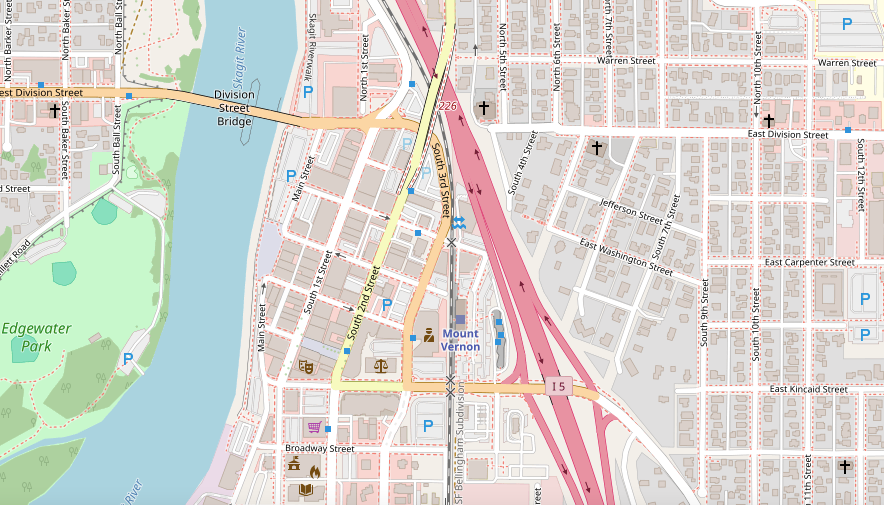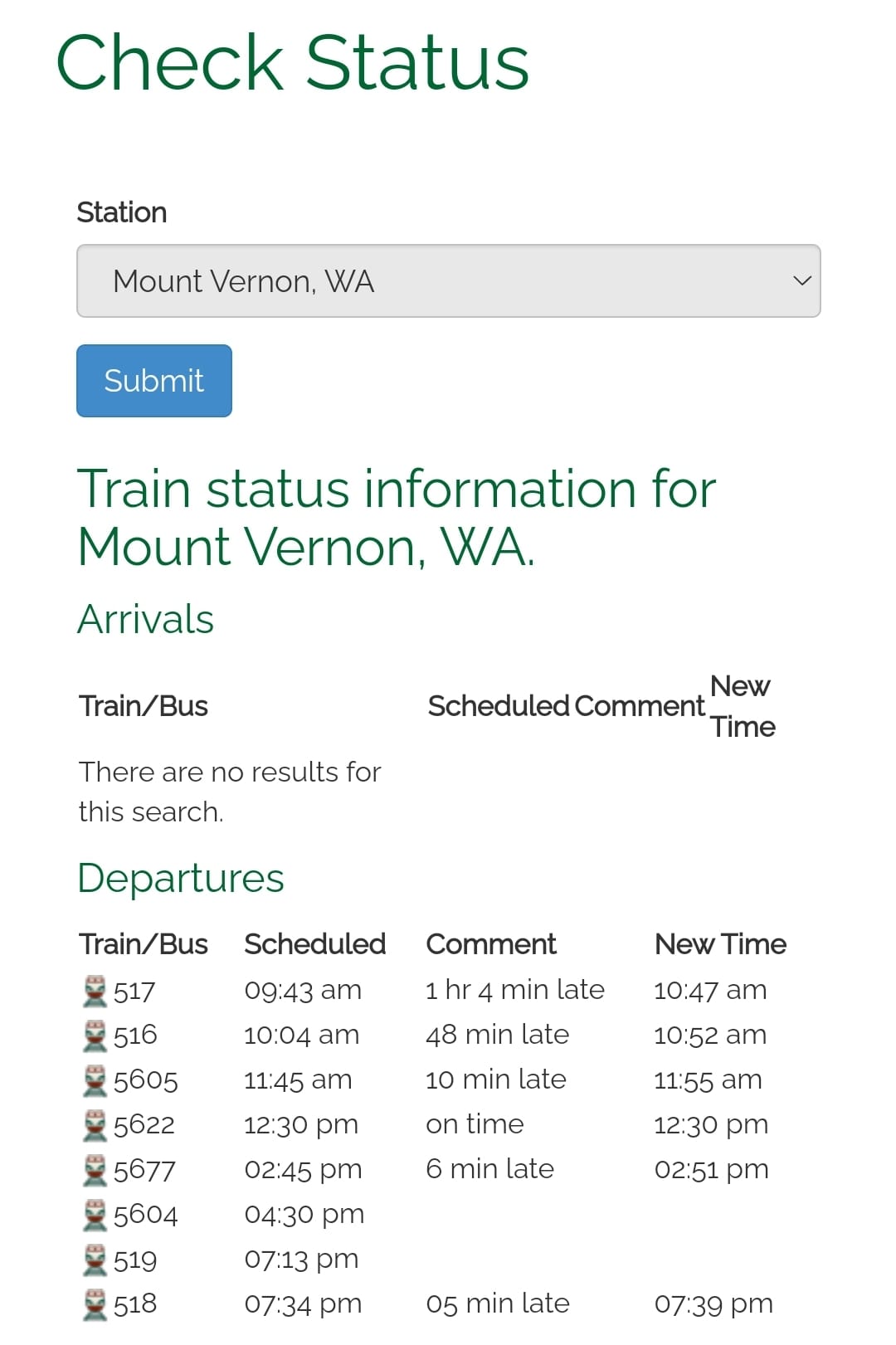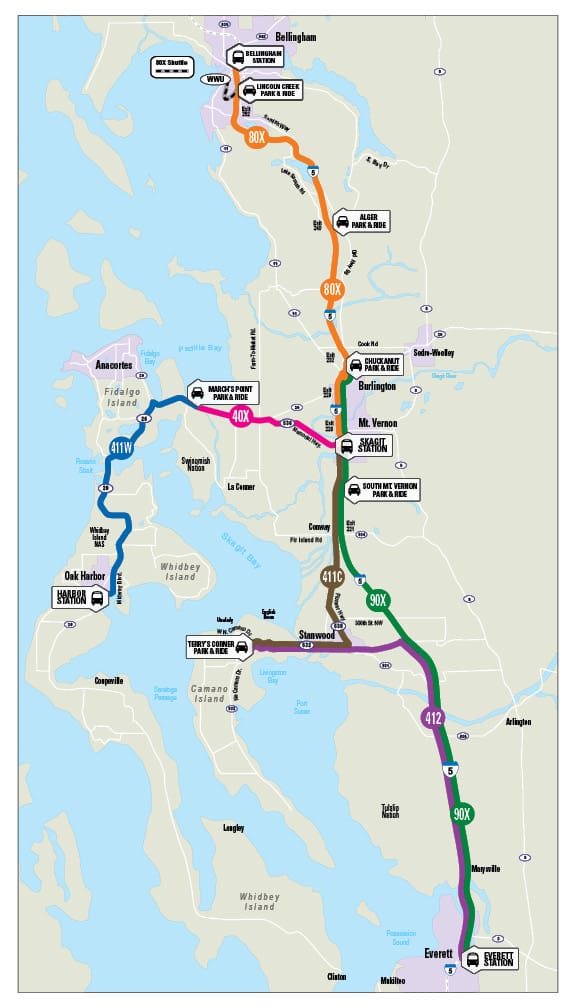How Mount Vernon’s Amtrak Choke Point Can Lead to Cascading Delays
Passenger train reliability issues make intercounty connector buses a critical backup for Bellingham.

The Amtrak Cascades southbound train, No. 517, was already 30 minutes behind schedule on Monday morning leaving Bellingham when BhamByBus, bound for some afternoon work meetings in Seattle, encountered more delays down the line in Mount Vernon. The cause wasn’t BNSF freight rail congestion nor was it an Amtrak mechanical issue. In this case, the train couldn’t depart Skagit Station in Mount Vernon due to an unfortunate on-board medical emergency from a passenger’s fall in a train car vestibule.
It took about 30 minutes for emergency medical technicians to arrive at Skagit Station, assess the injured passenger, and safely remove them from the train for additional medical attention. The emergency train-stoppage happened in one of the worst spots along the Amtrak Cascades corridor north of Seattle for such a disruption to happen. That’s because there’s only one track through Downtown Mount Vernon and the Skagit River, meaning that if a passenger train dwells at the platform for an especially long length of time, the more that delays can start cascading along the rail corridor.
In this case, the northbound Amtrak Cascades train, No. 516, was waiting on a rail siding south of Mount Vernon for the southbound train, No. 517, to leave the station and clear the single rail track section so the northbound train could continue. The southbound train departed Mount Vernon 1 hour and 4 minutes late, according to Monday’s Amtrak Cascades station status information. The northbound train ended up departing Mount Vernon 48 minutes late. BNSF freight trains were almost assuredly delayed, too, elsewhere along the rail corridor north of Seattle.

So, what can Bellinghamsters and others in Whatcom County learn from the single-tracked rail choke point in Skagit County? First off, with only a single track through much of the Skagit Valley, Bellinghamsters shouldn’t expect more reliable Amtrak Cascades passenger rail service until there are are longer and additional sections of double track in Skagit and Snohomish counties allowing more opportunities for trains to bypass disruptions on an adjacent track.
Unfortunately, an examination of the Washington State Department of Transportation’s Amtrak Cascades Preliminary Service Development Plan, which outlines options for future capital improvements and intercity passenger rail service expansion in Western Washington, does little to expand track capacity between Seattle and Bellingham.
As BhamByBus wrote on June 30:
Aside from some track upgrades in the vicinity of BNSF’s Delta Yard in Everett, there’s nothing else envisioned between Bellingham and Seattle on WSDOT’s conceptual list of track improvements. If BhamByBus had a magic wand or billions to throw around to make rail improvements materialize, we’d also expand track capacity along the relatively straight sections through Skagit County and northwestern Snohomish County, plus new rail bridges crossing the Snohomish River Delta to support higher-speed trains, a frustrating stretch that currently force trains to crawl across the aging bridges between Everett and Marysville.
Until there’s expanded rail capacity to alleviate the single-track choke points in Mount Vernon and elsewhere in the Skagit Valley, Bellinghamsters will continue to suffer from sometimes unreliable passenger rail service.

That’s why good regional intercounty bus connections are essential for Bellingham. They can serve as a backup when Amtrak Cascades sees major delays. When BhamByBus was delayed in Mount Vernon on Monday morning, there was a Skagit Transit Route 90X bus to Everett scheduled to depart relatively soon. But then the train continued south, more than an hour behind schedule.
- Have local and regional transit and transportation news to share? Email BhamByBus.
- Follow BhamByBus on Instagram.
